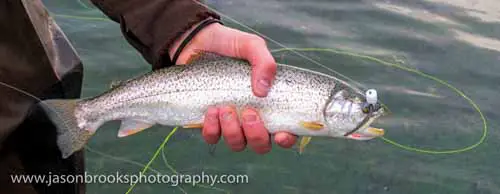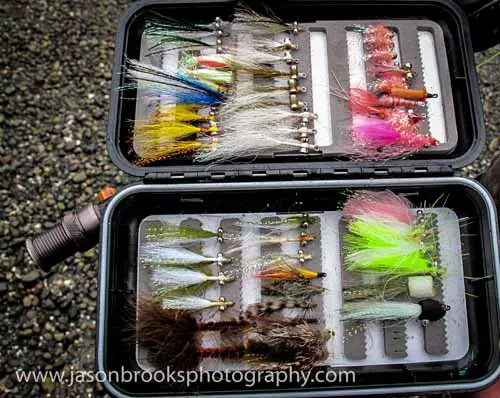Search
Latest Articles
Puget Sound Searun Cutthroat
by Jason Brooks, February 27, 2017
“Buddy, what’s up?” his reply, “Wanna go fishing in the morning, the tides will be perfect at first light?” I followed up with a simple question “What the heck are you talking about, there’s nothing going on Puget Sound” and that’s when he began telling me about landing ten to twenty fish in a two-hour window targeting Sea Run Cutthroat. He continued to explain that the high tide was going to be 8:00 AM and that by then all of the fishing will be over meaning we could be home by 9:00 which is around the time my kids wake on Saturday mornings anyway. I had all sorts of questions and began to ask a few of them when I felt that same “polite stare” at the back of my neck. I turned around and realized dinner was over with the table cleared, all except my plate which was cold; “Buddy, I gotta go, but I’m in for the trip tomorrow. What’s the details, and keep it quick”. He said to bring my waders and my 6 weight fly rod with floating line, he had all the rest, which was basically the fly pattern’s we would need and added to meet at 4:30 at our corner gas station.
The next morning I followed him to his new found spot, a point he described as “The point”, luckily I paid attention to the street signs along the way and figured out where we were. In the early morning blackness we donned our waders and used the dome lights of our trucks to string our rods and tied our tippets. He handed me a size 6 clouser minnow with an olive green back, white bottom and some flashabou mixed in. I tied it on and he assured me that if I lost the fly he would give me another one but he has yet to lose any flies this early in the season. We then walked down a dirt road passing a gate stating the land belonged to a private timber company that allowed walk in access. When we got to the bottom of the road we noticed a car parked and I got a bit nervous at the sight of a tent. Turns out this place is popular with the companies employees for “camping” and we snuck by the tent not waking anyone inside.
At the water’s edge I could make out shapes in the early morning light. I was cautioned not to get too close as it would spook the fish. The grey morning would keep the fish biting longer than normal as the dark waters hid them from Osprey and Eagles. Pointing his rod at the water I was shown a fish that was feeding on the bottom. The tip of the tail barely sticking above the surface as the fish found snails and small bugs on the bottom in the shallows. I guessed it was about a 12-inch cutthroat in 6 inches of water.

Standing several feet from the shores edge we began casting, landing the fly as gently as we could on the surface. At first my buddy just let it sit there as the ripples spread until the water was calm again. He then began stripping the fly in at an even pace until I saw him quickly lift the rod with an arch and whisper “Fish on”. He played the fish until it finally came to the beach. Picking it up gently he showed me the bright silver fish and its dark freckles; the cut under its mouth was a dull orange. Removing the fly he slid the fish back into the water.

As the night’s shadows faded we began to step into the water. I saw a fish surface about 20 feet out and realized that the fish were moving to deeper water as the cover of darkness that protected them from overhead predators was gone. Their camouflaged backs helped the cutthroat in the early morning light and soon the surface was erupting in feeding fish on the surface as my fishing buddy switched to a pattern he developed. It was a clouser minnow but with a foam “popper” head and the eyes were turned under the eye of the hook. He explained that these fish will attack this pattern as they are feeding on small schools of Chum Salmon fry. This particular fly resembles a stunned Chum fry that is floating on the surface, soon images of my kids last goldfish flashed through my mind when I found it dead and floating on top of its fishbowl. It made sense as I looked at the pattern.

I stepped out into the water and began to cast. It had been a few years since I swung a fly rod over my head and though I kept thinking I was loading my rod instead I piled the line onto the water making a big splash. My fishing partner quietly stepped away from me keeping his distance so his fish would be undisturbed by my bad casting. After a few minutes I was able to reach far back with a pause allowing the line to catch up with itself and then thrust it forward and lay the line gently onto the mirror surface. The clouser minnow would make a small circle as it landed. I would only make one or two casts between fish with most around the ten to twelve inch. Then my fishing partner set the hook on a fish and this time didn’t whisper as he said, “Fish”. The cutty erupted out of the water and was all of 16 inches. He kept the pressure on the fish until he was able to slide it into his open palm. I took a photo and he eased it back into the water. That’s when we heard the guy behind us say; “Nice fish” turning around there was the “camper” sipping a cup of coffee enjoying the show we were putting on.

Since we knew the guy wasn’t going to kick us off his camping spot I began fishing again. I ended up landing two more fish before I felt the water rising and the tide incoming. Soon seaweed and kelp were clogging our fishing grounds. The cutthroat were still rising, not as prevalent as before, but they were still feeding when we called it a morning. I then figured out why this was a short window to fish as the tides brought in the small schools of Chum fry for the cutthroat but also made it impossible to fish the clouser minnows once the tides slowed and filled in with the weeds.
As we walked back up the dirt road to our trucks I said to my friend that this would be a fun fishery on my 3 weight rod. He agreed but warned that the resident Coho swim these same waters and eat the same small fish and bugs and if I hooked a Coho I would surely lose the fish and fly.
To fish for Puget Sound Cutthroat all you have to do is look for beach access along any point, bay, or cove and you will find fish. Luckily there are plenty of state and county parks that offer just that. In the south sound look to Sunnyside Beach Park near Steilacoom or Penrose State Park on the Key Peninsula for access. Near Tacoma just south of the Narrows Bridge is Narrows Park that provides great beach access all along the west side where the fish feed during the slack and low tides. Walk north to Point Evans and fish the back eddy on the outgoing or right at the marker on the incoming tide. Dash Point State Park offers fishing along the banks near the fishing pier but there is no need to venture out onto the crowded pier as the fish cruise along the shoreline.
The public beaches near Kingston and Point No Point Lighthouse can be productive for those on the Kitsap Peninsula. Across the sound from there the beaches along Whidbey Island are just as good, try Fort Ebey State Park or Fort Casey State Park which has over 10,000 feet of saltwater shoreline to fish. If you have a boat then the entire Puget Sound that offers grassy coves or jutted points is at your mercy. Finding a place to fish and finding the fish themselves really isn’t a problem and this is one of the most under fished fisheries that I have discovered.
Clouser minnows are the most popular fly patterns, with the olive green and white or a bright green and white being very good colors. But also shrimp patterns and sculpins will catch fish. Damselflies in summer will draw Cutthroats to the surface as well. Remember to keep the flies fairly small as the fish aren’t that big and a size 6 to size 10 hook is ideal. I have tied some clouser minnows with a trailer hook that articulates like a tail of the fry or small baitfish as I strip it in. The trailer hook is secured to the main hook with 30 pound braid. Both hooks are barbless as in any other salt water fishery for anadromous fish the hooks can’t have any barbs.

My friend was right about keeping your gear fairly stout for these little trout. A six weight rod is ideal as you still get to fight the fish but isn’t too overbearing. During the summer and fall you might want to consider using an eight weight rod as the resident Coho as well as the migratory Coho are moving in and chasing the same baitfish as the Cutthroat. We fished floating lines since this allowed us to pause before stripping in the clouser minnows as the Cutthroat are pretty skittish to overhead dangers. Tippets were fairly long, again due to the jittery fish. I started my tipped with a two-foot section of fifteen-pound clear monofilament and then stepped it down to a two-foot section of ten-pound test to the last three-foot section of six-pound test. I favor Izorline’s XXX which is strong and yet limp and used a blood knot to connect the sections.
The best times to fish are early mornings and late evenings as the fish use the low light to come to the surface and feed. Tides are a factor too as it moves the bait as well as the weeds around. If you find a day where the tide is incoming with an hour or two of first light just before the high tide then it’s time to go fishing. I have found that even on weekends the beaches are almost completely void of people in the early hours of dawn. The evening time can be a bit harder as you have beachcombers, joggers, swimmers, and people throwing sticks for their dogs into the water’s edge but if you have a beach of solitude then this can be another great time to fish, especially in summer. It’s hard to beat a summers evening swinging a fly into Puget Sound from the shore for Sea Run Cutthroat’s.
You don’t have to fish in the spring or summer as any time of year you will find the fish cruising the shoreline. Most marine areas are open year around but all Cutthroat fishing in Puget Sound is catch and release. Make sure you check out the local laws regarding park hours when fishing at public beaches, though most open before sunrise and close after sunset. It might not be fishing the Yellowstone for West Slope Cutthroats, Clark Fork Browns, or upper Kenai Rainbows but if you live anywhere near Puget Sound don’t overlook a fishery that can be outstanding, even if for just a few short hours on a Saturday morning before the rest of the family wakes.




